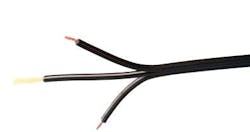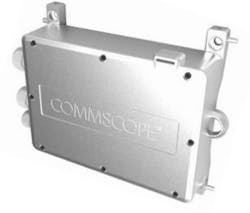FiberREACH Serves Data- and Power-Hungry Edge Devices
CommScope unveiled its FiberREACH solution as part of its SYSTIMAX 2.0 portfolio on June 20. When announcing the system, CommScope said it “is designed to help enterprise network providers quickly and reliably extend power and connectivity to support more devices and applications at the edge.”
FiberREACH is an enhancement to the solution formerly called the Powered Fiber Cable System (PFCS); CommScope says FiberREACH “builds on this innovative solution by offering enhanced functionality while satisfying established customer requirements. The FiberREACH portfolio uses a range of hybrid cabling solutions to provide gigabit speeds to the network edge. As edge devices have evolved, the need for additional power has become essential. The FiberREACH portfolio now delivers up to 90W of power to the edge, supporting both power- and data-hungry devices. With these innovations, the FiberREACH platform meets the full range of Power over Ethernet [PoE] standards.”
CommScope further explained that FiberREACH builds on the GigaREACH XL portfolio, using a range of fiber types and copper gauges to provide customer-specific solutions. It delivers support for legacy, new, and future architectures, providing up to 90W PoE, with one power supply panel feeding up to 32 devices simultaneously.
The company also characterizes the systems as compact and scalable, citing its “high-density performance that supports passive as well as active optical network architectures.” Its 25-year extended product and application warranty ensure peace of mind for users. CommScope pointed out FiberREACH is “fully PoE-compliant and compatible with Spanning Tree Protocol for redundant fiber connections and greater reliability. It provides more power where needed—up to 350 meters away.”
Each 12-AWG conductor in the hybrid cable supports the following.
- 7W up to 4600 meters
- 15W PoE up to 3000 meters
- 30W PoE up to 1800 meters
- 60W PoE up to 880 meters
- 90W PoE up to 350 meters
On a portion of its website dedicated to the FiberREACH solution, CommScope explains, “There are options for extending the reach of your structured cabling beyond 100 meters. Each has pros and cons, but none present an especially compelling business case.” It details the scenarios as follows.
Add another telecom room—Pros: Is standards-compliant and offers the potential to house additional equipment. Cons: Sacrifices space, is costly, requires disruptive construction, and introduces more failure points and repair costs.
Add PoE extenders—Pros: Provides 2x the channel length with longer spans possible using daisy-chaining, and is relatively easy to deploy. Cons: PoE comes with bandwidth limitations, as well as the possibility f more failure costs.
Replace copper with fiber—Pros: Span up to several kilometers and deliver far more data. Cons: Requires optical transmission equipment and media converters, and requires separate power costs.
Use an extended-reach PoE cable—Pros: Claims to support PoE greater than 100 meters, and is fast and easy to deploy. Cons: Performance depends on chip type, and there is no guarantee of extended-reach performance.
CommScope further explains with the FiberREACH platform, you can “deliver more power and data over longer distances to support AI and IoT edge devices, in-building and across campus—all while simplifying the network, reducing costs, and getting the consistent performance of a standards-compliant link.”
The power supply/UPS rack-mounted panel occupies minimal space in the telecom room. One power panel supports up to 32 devices simultaneously. The hybrid power/fiber cabling combines multimode or singlemode fiber and low-voltage copper conductors in one flexible hybrid cable that fits inside a conduit. And PoE extenders terminate the hybrid cable near the devices. Category 6A patch cords connect the devices.
“In developing the FiberREACH platform, SYSTIMAX engineers improved the traditional PoE extender, especially for the highest current wattage [90W] applications,” the company says. “The patented concept integrates voltage regulation, Ethernet, and a splice tray in a single enclosure designed for use with hybrid cable. It’s ideal for emerging applications such as multiple-lens and IR cameras, plus AI and IoT network edge architectures.”

